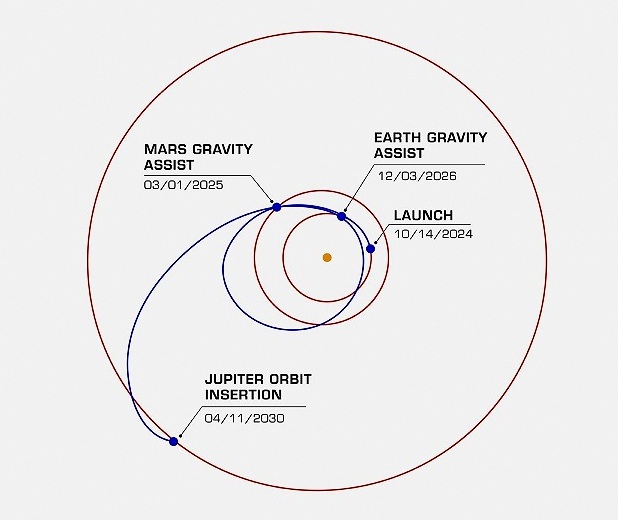Europa Bound
Iimages of Europa's chaotic surfaces (credit: Galileo/JPL/NASA)
The Europa Clipper began its long odyssey after a flawless launch from the Kennedy Space Center in Florida last October 2024.
According to the Jet Propulsion Laboratory (JPL), when the spacecraft reaches Jupiter the remote sensing lab will survey the icy Jovian moon, Europa. The Mission's name hearkens back to the era of 15th and 16th Century's clipper ships that sailed the Earth's oceans making discoveries everywhere they landed. It represents the largest spacecraft ever built weighing 13,000 pound and will become even larger than a basketball court when its array of solar panels are fully extended. This 21st Century 'clipper' will fly past Europa's surface 49 times, coming as close as 16 miles above its ice hoping to discover the if the moon has the chemical ingredients necessary for life.
Europa's surface features were first observed during earlier encounters by NASA's Galileo probe which orbited Jupiter over 14 years before ending its mission in 2003. During that period, the robotic craft documented the internal and external processes shaping moon's icy crust. Its features, likely resulting from the presence of a liquid water ocean beneath the ice shell, are seen as dark spots, lobe-shaped flows, mottled terrain, knobs, and dark areas along ridges and banded zones. A collage consisting of Galileo images illustrates the diversity of these surface contours and are reshaped from the constant tugging of Jupiter's massive gravity. Europa's neighboring moons, Io and Ganymede also pull on Europa as they orbit the gas giant planet. These combined gravitational forces affect the moons interior and exterior producing chaotic terrain by the alternating extension and compression forces tugging at moon's icy surface. The novel, deformed structures will receive major attention by the Clipper's sensors, scanners, and spectrometers to determine their composition and chemistry.

Europa Clipper in protective nose-cone (credit: NASA)
The spacecraft will begin orbiting Jupiter in 2030 and begin a series of science-focused flybys of Europa, while looping around the gas giant. A variable orbit was designed to maximize the science and minimize the exposure to Jupiter’s intense radiation which could damage the probe's suite of instruments. The Clipper was launched encased in a protective nose-cone atop a SpaceX Falcon Heavy rocket carrying over 6,000 pounds of the propellant required to reach Jupiter.
The Europa Clipper will sail nearly 2 billion miles on a trajectory that will leverage two gravity assists, first from Mars this year and then a second flyby past Earth in 2026. The flawless launch required the precision of a 15 second window to meet its required path to Jupiter. Five minutes after the liftoff, the rocket's second stage fired and its payload in the nose cone, opened to reveal its contents. An hour afterwards, the craft separated from the rocket and was bound on its voyage.
Europa Clipper has now completed its first gravity assist when it recently streaked within 550 miles above the Martian surface. The maneuver bent its path trajectory to be in the proper position it for the next eg in its voyage to Jupiter. The Mars assist allowed JPL scientists to test the Clipper's radar and thermal infrared imager. The spacecraft captured infrared images of the planet to help JPL calibrate its thermal imager so the Lab can be sure it is operating correctly when the probe arrives at the Jovian system in 2030.

Colorized composite of several Mars images by thermal IR imager. Red areas are ~+32F and purple regions are ~ -190 F (credit: NASA/JPL-Caltech/ASU)
Thermal imaging is a key element of the Europa science investigations to produce global scans of the icy moon. Temperature maps offer strong insights on how active is the surface of Europa. Infrared imaging will reveal how much heat is being emitted from the moon and if warmer regions of the ice give off more energy and indicate recent activity. The imaging will also tell the researchers where the ocean is closest to the surface. Europa is crisscrossed and discolored by dramatic ridges and fractures, which previous mission indicate may be caused by an ocean tidal convections that pulling apart the icy crust with water rising up to fill the opened gaps.
Credit: NASA/JPL-Caltech/ASU

Gravity assisted maneuvers to set flight path to Jupiter (credit: JPL)
As it departed the Red Planet, the Clipper was traveling at nearly 14 miles/second. The 2nd assist will happen in December 2026 during a close encounter with Earth. That maneuver will act as a 'slingshot' to give the spacecraft a velocity boost to the outer Solar System. After that, it will be on a straightforward path to arrive at Jupiter in April 2030. An animation illustrates the Mars flyby.
The wonders awaiting discovery by this 21st Century 'clipper ship' can only be imagined. WHB